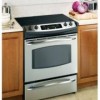GE JS900 Owners Manual - Page 9
Safety Instructions, Care and Cleaning, Troubleshooting Tips, Consumer Support, Operating Instructions
 |
View all GE JS900 manuals
Add to My Manuals
Save this manual to your list of manuals |
Page 9 highlights
Safety Instructions Operating Instructions Care and Cleaning Troubleshooting Tips Consumer Support Right! Wrong! Note: Flat-bottomed canners are required for glass cooktops. ge.com Observe the Following Points in Canning Pots that extend beyond 1″ of the surface unit's circle are not recommended for most surface cooking. However, when canning with water-bath or pressure canner, larger-diameter pots may be used. This is because boiling water temperatures (even under pressure) are not harmful to the cooktop surfaces surrounding the surface units. HOWEVER, DO NOT USE LARGEDIAMETER CANNERS OR OTHER LARGE-DIAMETER POTS FOR FRYING OR BOILING FOODS OTHER THAN WATER. Most syrup or sauce mixtures-and all types of frying-cook at temperatures much higher than boiling water. Such temperatures could eventually harm the glass cooktop surfaces. Be sure the canner fits over the center of the surface unit. If your cooktop or its location does not allow the canner to be centered on the surface unit, use smallerdiameter pots for good canning results. Flat-bottomed canners must be used. Do not use canners with flanged or rippled bottoms (often found in enamelware) because they don't make enough contact with the surface units and take a long time to boil water. Remember that canning is a process that generates large amounts of steam. To avoid burns from steam or heat, be careful when canning. NOTE: If your house has low voltage, canning may take longer than expected, even though directions have been carefully followed. The process time will be shortened by: (1) using a pressure canner and ( 2) starting with HOT tap water for fastest heating of large quantities of water. CAUTION: s Safe canning requires that harmful microorganisms are destroyed and that the jars are sealed completely. When canning foods in a water-bath canner, a gentle but steady boil must be maintained for the required time. When canning foods in a pressure canner, the pressure must be maintained for the required time. s After you have adjusted the controls, it is very important to make sure the prescribed boil or pressure levels are maintained for the required time. s Since you must make sure to process the canning jars for the prescribed time, with no interruption in processing time, do not can on any cooktop surface unit if your canner is not flat. When canning, use recipes and procedures from reputable sources. Reliable recipes and procedures are available from the manufacturer of your canner; manufacturers of glass jars for canning, such as Ball® and Kerr® brand; and the United States Department of Agriculture Extension Service. 9















